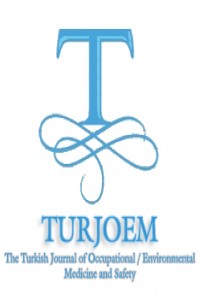Öz
Welding is an
industrial process that materials are joined by fusion. The health hazards
related to welding are well discussed and
the toxic effects of welding to the lungs are already known. But the
effects of heavy metals exposure
during welding on the lungs are currently equivocal. In this study we
investigated the association
between lead and cadmium levels and pulmonary function among welders.
This is a
descriptive study. Two hundred seven non-smoker male participants included
controls and welders who presented
Ankara Occupational Disease Hospital for annual medical examination were included to the study. Three groups
were classified; which 61 of them
were controls, 96 of them were exposed workers, working less than 4 hours a day
and 50 of the participants were exposed workers, working more than 4 hours a
day. Existence of recent acute or chronic diseases, having medications and
smoking used for exclusion. We assessed symptoms, performed spirometry,
measured serum Cd and lead levels in all study subjects. Also we tested the
association between serum Cd and lead levels and lung function using multiple
regression analysis.
FVC and FEV1
increased and FEV1/FVC decreased in welders who were exposed to metal fumes
less than 4 hours a day (p<0.0001). The group whom exposed more than 4 hours
had increased FVC levels and decreased FEV1 and FEV1/FVC levels (p<0.0001).
Blood cadmium and blood lead levels increased in both groups with exposure to
welding fumes (p<0.0001). Participants who were exposed above 4 hours a day
had significantly decreased FVC, FEV1, FEV1/FVC, PEF values (p<0.0001). All
parameters (FVC, FEV1, FEV1/FVC, PEF) where decreased in participants with high
blood cadmium levels and the difference is statistically significant
(p<0.0001).
This present
study clearly shows that pulmonary functions are associated with exposures
during welding. The increased working hours are correlated with impairment in
pulmonary functions. So this study reveals the clues of systemic toxicity
associated with welding and the detrimental effects to the lungs which our
findings supports the hypothesis.
Kaynakça
- Department of Occupational Medicine, Hacettepe University Faculty of Medicine, Ankara, Turkey
- Department of Public Health and Primary Care, College of Medicine, Nursing and Health Sciences, Fiji National University, Fiji3 3Department of Family Medicine, Ankara Occupational Diseases Hospital Ankara, Turkey
- Department of Biochemistry, Ankara Occupational Diseases Hospital Ankara, Turkey
- Department of Public Health, YıldırımBeyazıt University Faculty of Medicine Ankara, Turkey
- The Council of Forensic Medicine Ankara, Turkey
- Department of Toxicology, Ankara Occupational Diseases Hospital, Ankara, Turkey
- Department of Medical Humanities and Social Medicine, College of Medicine, Kosin University, Korea
Öz
Kaynakça
- Department of Occupational Medicine, Hacettepe University Faculty of Medicine, Ankara, Turkey
- Department of Public Health and Primary Care, College of Medicine, Nursing and Health Sciences, Fiji National University, Fiji3 3Department of Family Medicine, Ankara Occupational Diseases Hospital Ankara, Turkey
- Department of Biochemistry, Ankara Occupational Diseases Hospital Ankara, Turkey
- Department of Public Health, YıldırımBeyazıt University Faculty of Medicine Ankara, Turkey
- The Council of Forensic Medicine Ankara, Turkey
- Department of Toxicology, Ankara Occupational Diseases Hospital, Ankara, Turkey
- Department of Medical Humanities and Social Medicine, College of Medicine, Kosin University, Korea
Ayrıntılar
| Bölüm | Articles |
|---|---|
| Yazarlar | |
| Yayımlanma Tarihi | 16 Şubat 2017 |
| Yayımlandığı Sayı | Yıl 2017 Cilt: Volume 2 Sayı: İssue 1 (1) - 2.İnternational Congress Of Forensic Toxicology |

